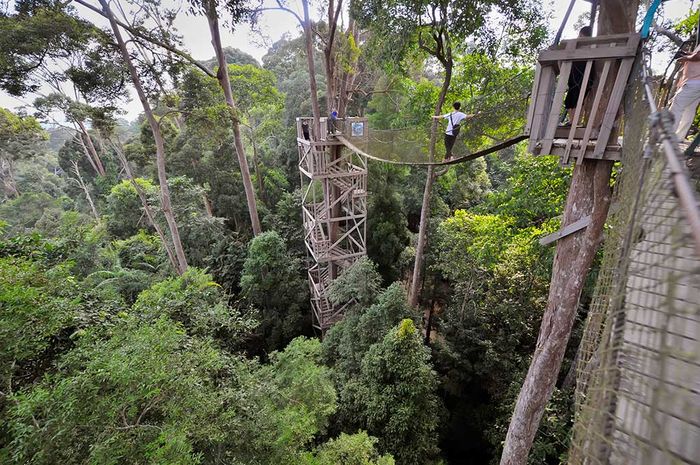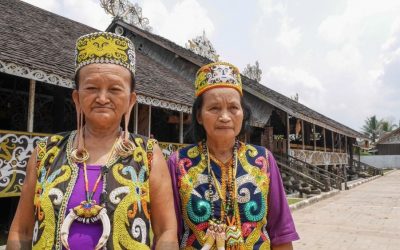Home / Batik Regions – Central Indonesia – Kalimantan Island – East Kalimantan / Bangkirai Hill Natural Conservation Site
Natural Destination
Experience the tropical nature!
Bangkirai Hill Natural Conservation Site
The Canopy Bridge at Bangkirai Hill (photo: Intisari)
Bangkirai Hill
If you have always dreamt to spend a night in a forest and do some adrenaline-pumping outdoor activities, you can do it in here. They also have a small restaurant to enjoy your meal in this tropical scenario. You will also discover the natural landscape as well as diverse flora and fauna unique to East Kalimantan.
Tourist Attractions in East Kalimantan
Pampang Cultural Village
This area is inhabited by Dayak Kenyah and once a year they
Batik villages in East Kalimantan
Home / Batik Regions - Central Indonesia - Kalimantan Island - East Kalimantan / Batik Village in East Kalimantan Batik Village in East Kalimantansupport the local workshop Brief Story: This unique batik from East Kalimantan are made with various materials. Some...
East Kalimantan
Batik Motifs
Tengkawang Ampiek
With its many advantages, the Dayaks use this leaf in ritual ceremonies. This plant is a symbol of
Hiu Taliyasan
Indonesia is also home to the world’s largest fish, the whale shark (Rhincodon typus). Hiu Taliyasan refers to
Kuntul Perak
Kuntul Perak refers to Egret Silver Bird. This bird is a Kalimantan endemic animal that becomes the
Discover
Indonesian
Batik
Motifs
Ake Patra
Ake is related to the divinity and the composition of the universe. It is a symbol of
Kaharingan
The Kaharingan or ‘tree of life’ based on the Dayak tribes’ belief system. This tree symbolizes
Ukir Sentani
The Ukir motif is a batik motif that is inspired by various traditional Sentani wood carvings
Bekantan Pakis
This motif represents Pakis Haji (Polystichum setiferum), an endemic plant in
Kaganga Tanah Rejang
If Batik Besurek combines Arabic calligraphy motifs, then the Kaganga batik takes
Tifa Totobuang
The batik motifs illustrate Maluku’s traditional music instrument called
Pinawetengan
The Pinawetengan Batik pattern was taken from a prehistoric inscription in
Tenun Bima
The motifs are adopted from Bima woven textile. This pattern has received a great
Tongkonan
Toraja’s traditional house is called Tongkonan. Tongkonan is a place for
Dayak Taghol
Dayak Taghol has a distinctive style of four curved lines and small dots. This motif represents
Pati-Pati Pinehiku
It symbolizes the hierarchy in society and the social status of the Mekongga
Karawo Pinang
Pinang refers to the Palm areca tree. This motif is considered as the original
Sido Mulyo
Sidomulyo is one of the classical motifs, which is specifically used for the bride’s costume in
Biji Kopi
The coffee seeds motif illustrates the pride of local coffee specialities in
Kuda Kupang
Horses symbolize wealth. It contains noble values of virtuous characters that bring
Merak Ngeram
The hatching peacock motif has a very deep meaning which refers to the sacrifice and
Pucuk Rebung Riau
Pucuk Rebung symbolizes heart determination in achieving goals, good luck, and
Kawung
The Kawung motif was created by Sultan Agung Hanyokrokusumo (1593 – 1645) as a symbolic gift for
Daun Sirih
This motif illustrates betel leaves that are used by Lombok communities as traditional
Sandeq
Sandeq Boat is a symbol of the maritime importance of the West Sulawesi region. The greatness of
Hiu Taliyasan
Indonesia is also home to the world’s largest fish, the whale shark (Rhincodon typus). Hiu Taliyasan refers to
Wakatobi
It symbolizes the coastal beauty of the Wakatobi island and the symbol of Patra symbolizes
Gorga Simeol-Meol
The Gorga Simeol-meol is a pattern of plant tendrils. it is regarded as a symbol of longevity and
Bultiya
The word ‘Bultiya’ is an acronym of the three major tribes in North Kalimantan, namely
Bomba Mawar
This motif means sacred love for family, kingdom, and God; It also illustrates
Daun Lada Hitam
The black pepper motif represents the main commodity of Bangka Belitung
Tengkawang Ampiek
With its many advantages, the Dayaks use this leaf in ritual ceremonies. This plant is a symbol of
Parang Rusak
Another meaning behind this motif is an unconquerable spirit, symbolized by
Leuit Sijimat
This motif reflects the daily activities of the Baduy tribe in Banten. The main ornaments of batik motif consist of:
Gigi Haruan Lidi
The Gigi Haruan Lidi motif is taken from the name of the cork fish and is a symbol of
Rangkiang
The word “Rangkiang” refers to the rice granary in the Minangkabau language. It symbolizes
Bintik Tujuh
The Bintik Tujuh (Seven Dots) motif has 7 white spots and green color gradation as
Bale Lumbu
This motif signifies the welfare of the ancient Sasak society. Bale also symbolizes the
Manguni Minahasa
Manguni is identified as the symbol of the Minahasa people. Manguni is known as a
Pala Salawaku
This motif illustrates the unique weapons of the Maluku region, namely
Sekar Jati
Sekar means flower and Jati refers to teak trees that symbolizes a strong mental character that
Besurek Rembulan
This batik illustrates praise for God who created the wonderful universe
Prada Papua
The word “Prada” in the Javanese-Indonesian dialect means a batik textile that
Singayaksa
The Singayaksa motif comes from the name of a place where Sultan Hasanuddin used to
Rumah Mamuju
the Batik motif illustrates the house of Mamuju King with the stairs, located on the left of the wooden stage house
Insang Ikan
Insang refers to the gills of the fish. This is a typical pattern of Malay ethnic who inhabits
Sero Tangga
The Sero Tangga illustrates an endearing feeling and sacrifices of a person to fulfil
Tangerang Herang
Tangerang Herang motif is a symbol of Tangerang city. The Tangerang Herang batik motif consists of
Karawo Mahkuta
Mahkuta refers to Gorontalo’s traditional crown. It represents noble characters of
Kain Cual
Cual textile tradition has existed since the 17th century. The word “Cual” refers to
Desa Na Tolu
The Desa Na Tolu characteristic pattern symbolizes the Batak philosophy of existence and
Pohon Hayat (Tree of Life)
The Batik motifs in Lampung are dominated by the acculturation of Buddhist and
Kerawang Tegak Aceh
The Vertical Upright (Kerawang Tegak) Motif symbolizes a person who has a strong
Raja Ampat
Raja Ampat motif represents the marine life at Raja Ampat archipelago in
Wirasat
Wirasat or divine inspiration is a gift from God. This inspiration is symbolized by
Parang Seling
Parang Seling or “alternating daggers” is a royal batik motif. It is a feminine variant of
Tampuk Manggis Sasirangan
The motif illustrates the philosophy of the mangosteen fruit, which is
Angsa Duo
According to legend, the Angso duo batik motif is a pair of swans that are believed to have led Princess
Gurdo Solo
Gurdo or garuda bird is the mount of the Indian god Vishnu. As the Sun Bird,
Jupri Kembang Teh
Kembang Teh illustrates the tendrils of tea plants that grow in the highlands of
Honai
The Honai is inspired by the traditional house of the Papuan community living in
Lontara
The Lontara script itself is a typical ancient script of Bugis and Makassar communities. History records that
Malinau Cultural Festival
You will witness a unique competition that might not be found other than in
Sekomandi
Its philosophical meaning is the eternal union which refers to a saying “until death do us part”
Teguh Bersatu
This batik motif shows the strength of the people of Kupang. It also represents a sense of
Awan Berarak
Awan Berarak is a combination of Dayak motifs and Malay patterns. The word ‘Awan Berarak’ means the
Taiganja
Taiganja is a precious gold pendant that shows the social status of the Kaili family. It is
Salakanagara
Salakanagara batik motif illustrates the first kingdom in the Betawi land
Ikan tambal
The word “Ikan” refers to fish. The philosophical meaning of Ikan Tambal means is
Gedhog Kembang Waluh
a combination of Javanese cultural motif of the Majapahit kingdom (XII-XIV century) with
Tabir Tanjung
Tanjung flower is a type of Cherry tree flower, which is commonly found in
Burung Bidadari
Bidadari birds are endemic birds in Halmahera. This motif represents an
Pattimura
Pattimura is the name of an Indonesian hero who fought against colonialism in
Jumputan Bintang
The word Jumputan means the tie-dye technique, while the word “Bintang” refers to
Tikar Natuna
The Tikar Natuna motif is adapted from the traditional making of pandanus mats in
Gajah Way Kambas
The motif illustrates the Lampung’s natural reserve, the Way Kambas. it also symbolizes
Mahkota Siger
Siger is the crown of a noblewoman in ancient time. It is a symbol of femininity, strength, and


